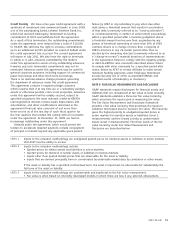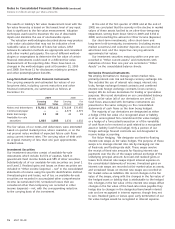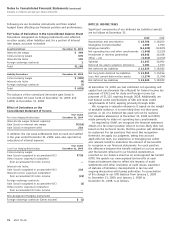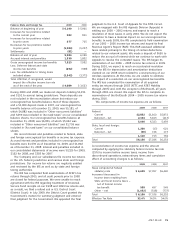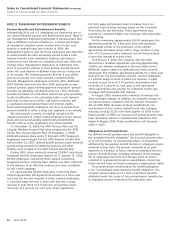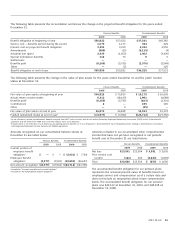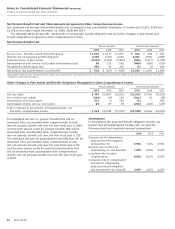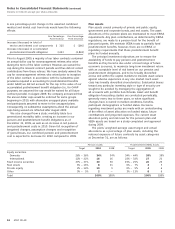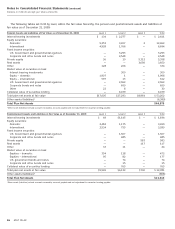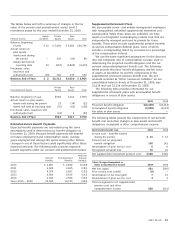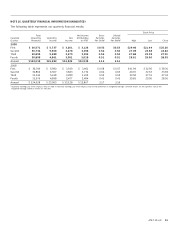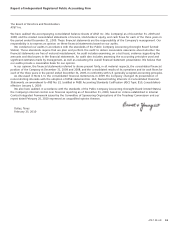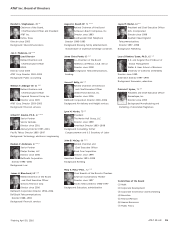AT&T Wireless 2009 Annual Report Download - page 87
Download and view the complete annual report
Please find page 87 of the 2009 AT&T Wireless annual report below. You can navigate through the pages in the report by either clicking on the pages listed below, or by using the keyword search tool below to find specific information within the annual report.
AT&T 09 AR 85
managers, which management has determined approximates
fair value. Private equity investments are often valued initially
based upon cost; however, valuations are reviewed utilizing
available market data to determine if the carrying value
of these investments should be adjusted. Such market data
primarily includes observations of the trading multiples
of public companies considered comparable to the private
companies being valued. Investments in real assets funds
are stated at the aggregate net asset value of the units
of these funds, which management has determined
approximates fair value. Real assets and natural resource
investments are valued either at amounts based upon
appraisal reports prepared by appraisers or at amounts
as determined by an internal appraisal performed by the
investment manager, which management has determined
approximates fair value.
Purchases and sales of securities are recorded as of the
trade date. Realized gains and losses on sales of securities
are determined on the basis of average cost. Interest income
is recognized on the accrual basis. Dividend income is
recognized on the ex-dividend date.
Fair Value Measurement
GAAP standards require disclosures for financial assets and
liabilities that are remeasured at fair value at least annually.
GAAP standards establish a three-tier fair value hierarchy,
which prioritizes the inputs used in measuring fair value.
These tiers include: Level 1, defined as observable inputs such
as quoted prices in active markets; Level 2, defined as inputs
other than quoted prices in active markets that are either
directly or indirectly observable; and Level 3, defined as
unobservable inputs in which little or no market data exists,
therefore requiring an entity to develop its own assumptions.
See Note 9 “Fair Value Measurement and Disclosure” for a
discussion of fair value hierarchy that prioritizes the inputs
to valuation techniques used to measure fair value.
At December 31, 2009, AT&T securities represented less than
one-half of a percent of assets held by our pension plans and
VEBA trusts.
Investment Valuation
Investments are stated at fair value. Fair value is the price that
would be received to sell an asset or paid to transfer a liability
in an orderly transaction between market participants at the
measurement date. See “Fair Value Measurement” for further
discussion.
Investments in securities traded on a national securities
exchange are valued at the last reported sales price on the
last business day of the year. If no sale was reported on
that date, they are valued at the last reported bid price.
Investments in securities not traded on a national securities
exchange are valued using pricing models, quoted prices of
securities with similar characteristics or discounted cash flows.
Over-the-counter (OTC) securities and government obligations
are valued at the bid price or the average of the bid and
asked price on the last business day of the year from
published sources where available and, if not available, from
other sources considered reliable. Depending on the types
and contractual terms of OTC derivatives, fair value is
measured using a series of techniques, such as Black-Scholes
option pricing model, simulation models or a combination of
various models.
Common/collective trust funds and 103-12 investment
entities are valued at quoted redemption values that represent
the net asset values of units held at year-end which
management has determined approximates fair value.
Alternative investments, including investments in private
equities, private bonds, limited partnerships, hedge funds,
real assets and natural resources, do not have readily
available market values. These estimated fair values may
differ significantly from the values that would have been
used had a ready market for these investments existed, and
such differences could be material. Private equity, private
bonds, limited partnership interests, hedge funds and other
investments not having an established market are valued
at net asset values as determined by the investment


